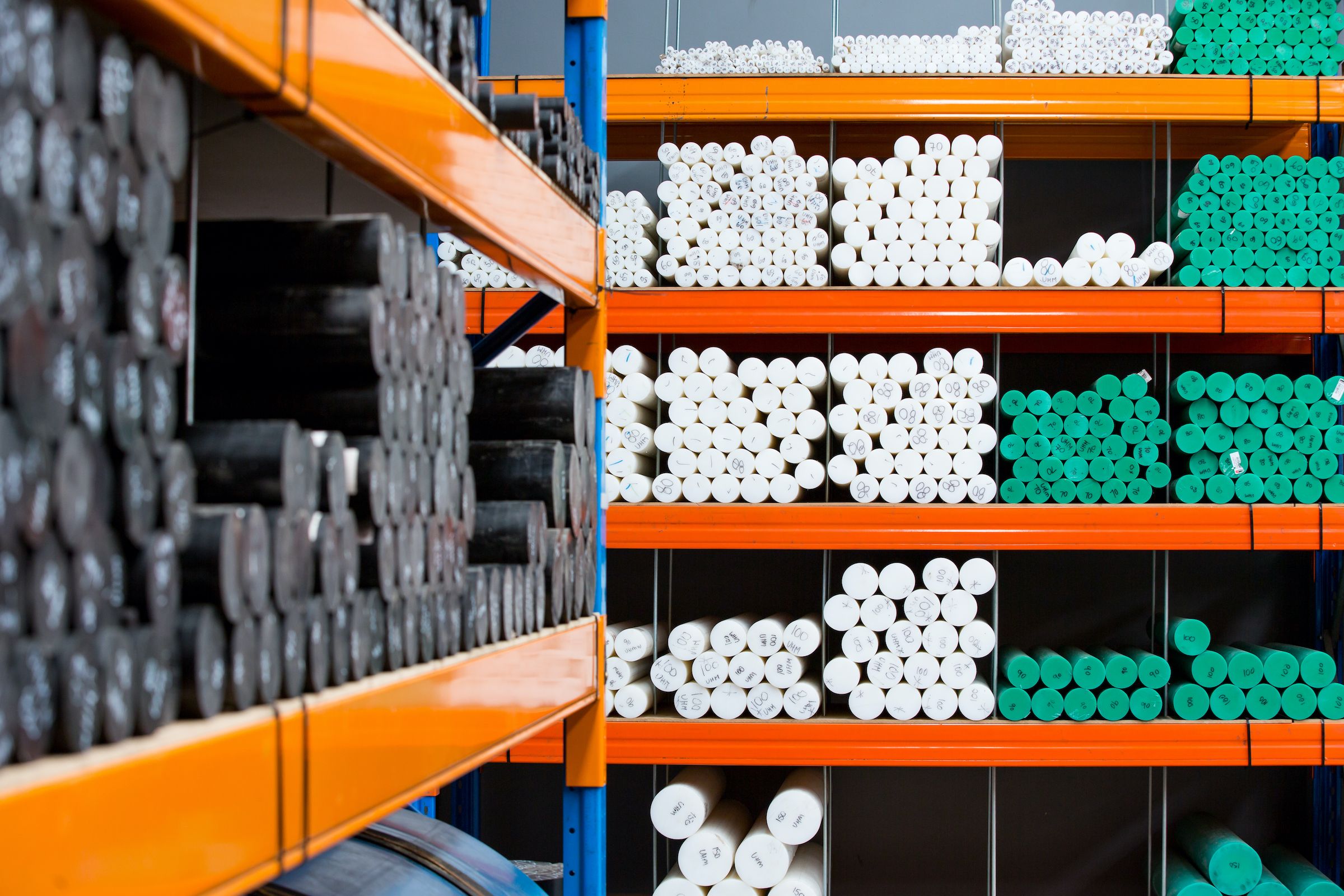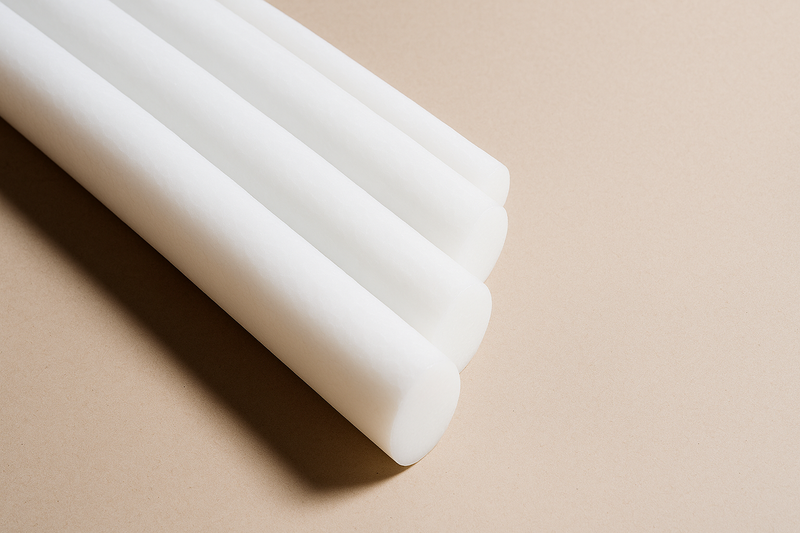At a glance
- FDA and FSANZ compliance is essential, but so is performance under high heat, chemicals, and mechanical stress.
- Each plastic (UHMWPE, HDPE, PTFE, Acetal, PEEK) offers unique advantages for food-grade tasks like cutting, conveying, sealing, or sterilising.
- Smart material selection improves hygiene, lowers contamination risk, and reduces maintenance costs.
- Choose plastics based on application needs, balancing safety, durability, and processing efficiency.
In the food and beverage industry, food safety compliance is non-negotiable. Every plastic component, whether a conveyor guide, cutting board, or fluid-handling part, must comply with strict food contact regulations to uphold hygiene standards and protect consumers.
However, regulatory compliance is only the starting point. In real-world production environments, plastics must also withstand repeated sanitation cycles, exposure to oils and aggressive cleaning agents, temperature extremes, and continuous mechanical stress.
Selecting the right FDA-compliant material means balancing compliance, durability, and operational efficiency while maintaining product safety and reducing downtime.
Below, we explore the top FDA-compliant engineering plastics and their ideal applications in food and beverage processing.
UHMWPE (Ultra High Molecular Weight Polyethylene)
UHMWPE plastic is a durable, low-friction engineering plastic designed to perform in high-wear environments. It offers exceptional resistance to impact, abrasion, and sticking, making it ideal for applications requiring repeated mechanical contact and strict hygiene standards.
Approved for food contact under FDA 21 CFR §177.1520 and compliant with FSANZ standards, UHMWPE is commonly used in the food industry, including processing lines, packaging systems, and bulk handling. Its self-lubricating surface reduces contamination risk and simplifies cleaning, ensuring safer contact surfaces.
In food applications, UHMWPE is commonly used in:
- Conveyor guide rails and wear strips for smooth, non-stick product transfer
- Commercial-grade cutting boards in high-traffic kitchens or meat facilities
- Hopper and chute liners to prevent sticking and buildup during bulk handling
- Food filling and packaging systems requiring extended service life and easy cleanability
Key Benefits of UHMWPE for Food and Beverage Applications
- Compliant with FDA 21 CFR §177.1520 and FSANZ for repeated food contact
- Minimises contamination risk with non-porous, bacteria-resistant surfaces
- Can be thoroughly cleaned using high-pressure water and sanitising chemicals without degrading or absorbing moisture
- Reduces equipment wear and downtime due to high abrasion resistance
Read more: Can UHMWPE be used in the Food Industry?
HDPE (High-Density Polyethylene)
HDPE plastic is a cost-efficient, food-safe plastic widely used in manufacturing, transport, and storage systems. It provides excellent chemical resistance, low moisture absorption, and ease of fabrication, making it ideal for static or low-stress food applications.
While not as mechanically robust as UHMWPE, HDPE offers a strong balance of performance and value for applications that do not involve high abrasion or continuous mechanical movement.
HDPE is approved for food contact under FDA 21 CFR §177.1520 and commonly complies with FSANZ’s Food Standards Code for food contact materials in Australia.
Common food-grade uses of HDPE include:
- Liquid food packaging, such as milk and juice containers
- Food-grade pallets and bins used in warehousing and distribution
- Piping systems in beverage and ingredient mixing lines
- Lightweight cutting surfaces and storage components in prep zones
Key Benefits of HDPE for Food and Beverage Applications
- Compliant with FDA and FSANZ for food contact in packaging and storage
- Resistant to cleaning agents used in industrial washdowns
- Stable in cold storage and ambient temperature ranges
- Low-cost fabrication and installation for bulk handling and processing environments
PTFE (Polytetrafluoroethylene)
PTFE plastic is a high-performance fluoropolymer used in food and beverage manufacturing where non-stick performance, thermal stability, and chemical resistance are critical. It is commonly used in seals, coatings, and fluid-handling components that must withstand harsh cleaning agents and high temperatures without degrading or contaminating the product.
PTFE is approved for food contact under FDA 21 CFR §177.1550 and is widely used in clean-in-place (CIP) and high-sensitivity zones, where material purity and hygiene control are paramount.
Common food applications of PTFE are:
- Gaskets, seals, and valve seats in high-temperature or chemically aggressive systems
- Release films and baking liners that prevent sticking during processing
- Pump diaphragms and O-rings in fluid-handling equipment exposed to acids or CIP chemicals
- Non-stick coatings on chutes, trays, or tools requiring efficient product release
Key Benefits of PTFE for Food and Beverage Applications
- Non-stick surface prevents buildup and cross-contamination
- Withstands CIP systems, steam sterilisation, and strong cleaning agents
- Chemically inert and non-leaching, ideal for dairy, oils, or acidic ingredients
- Enhances efficiency in sealing, dispensing, and baking operations
Acetal (POM)
Acetal is a rigid, low-friction thermoplastic valued in food and beverage manufacturing for its dimensional stability, wear resistance, and machinability. It performs exceptionally well in moving parts that demand tight tolerances, making it ideal for high-speed conveyors, rotary filling systems, and precision pump assemblies.
Acetal is available in food-contact grades compliant with FDA 21 CFR §177.2470 and EU Regulation 10/2011, ensuring safe use in regulated production environments.
Common food-grade applications of Acetal include:
- Conveyor sprockets, guide wheels, and rollers for high-speed motion
- Pump and valve housings requiring pressure stability and chemical resistance
- Cams and gears in packaging lines that are exposed to repetitive motion
- Bearings and bushings in dairy or meat equipment that require low friction
Key Benefits of Acetal for Food and Beverage Applications
- Excellent dimensional stability for smooth conveyor and pump operation
- Low moisture absorption in humid or washdown-prone settings
- High wear resistance for long service intervals
- Available in FDA and EU-compliant grades for repeated food contact
PEEK (Polyether Ether Ketone)
PEEK is a high-performance thermoplastic engineered for extreme food and beverage manufacturing environments where high heat, chemical exposure, and mechanical stress are common. It is ideal for components in bottling, pasteurisation, steam sterilisation, and CIP (Clean-in-Place)/ SIP (Sterilise-in-Place), where reliability is non-negotiable.
PEEK plastic is approved for repeated food contact under FDA 21 CFR §177.2415 and meets EU 10/2011 requirements, making it suitable for use in sterile or hygiene-critical zones.
Common food applications of PEEK are:
- Seals, bushings, and bearings in thermal processing and bottling systems
- Fittings and connectors in CIP/SIP systems exposed to repeated sanitation
- Load-bearing precision parts in bottling and capping machines
- Metal-replacement components in sterile food zones that are prone to corrosion
Key Benefits of PEEK for Food and Beverage Applications
- Withstands high heat and harsh chemicals in CIP/SIP and thermal systems
- Enables metal replacement, improving hygiene and reducing corrosion
- High fatigue and load resistance for demanding filling and capping operations
- FDA and EU compliant for continuous food contact use
The plastics used in food and beverage manufacturing are critical to ensuring hygiene, regulatory compliance, and process reliability. While FDA and FSANZ approvals are essential, performance in real-world processing environments matters just as much.
Whether it’s enduring harsh sanitation cycles, withstanding abrasive ingredients, or maintaining precision in high-speed machinery, the right engineering plastic helps you reduce downtime, lower contamination risks, and extend equipment lifespan.
Need help selecting the right FDA-compliant material for your food or beverage application?
Explore ePOL’s online portal to compare material options and place orders with confidence. Or feel free to contact our team for expert guidance.








